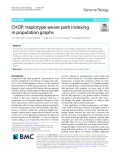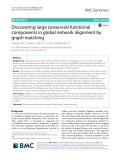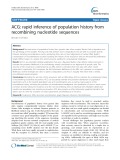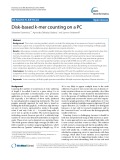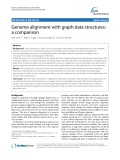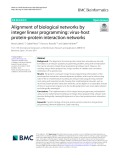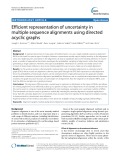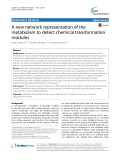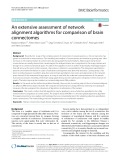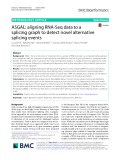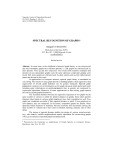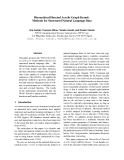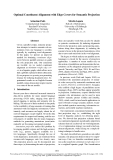
Graph alignment
-
There is growing interest in using genetic variants to augment the reference genome into a graph genome, with alternative sequences, to improve read alignment accuracy and reduce allelic bias. While adding a variant has the positive effect of removing an undesirable alignment score penalty, it also increases both the ambiguity of the reference genome and the cost of storing and querying the genome index.
 16p
16p  vigalileogalilei
vigalileogalilei
 27-02-2022
27-02-2022
 10
10
 1
1
 Download
Download
-
Genome graphs can represent genetic variation and sequence uncertainty. Aligning sequences to genome graphs is key to many applications, including error correction, genome assembly, and genotyping of variants in a pangenome graph.
 28p
28p  viarchimedes
viarchimedes
 26-01-2022
26-01-2022
 8
8
 0
0
 Download
Download
-
During the last decade, the analysis of ancient DNA (aDNA) sequence has become a powerful tool for the study of past human populations. However, the degraded nature of aDNA means that aDNA molecules are short and frequently mutated by post-mortem chemical modifications.
 18p
18p  viarchimedes
viarchimedes
 26-01-2022
26-01-2022
 7
7
 0
0
 Download
Download
-
The practical use of graph-based reference genomes depends on the ability to align reads to them. Performing substring queries to paths through these graphs lies at the core of this task. The combination of increasing pattern length and encoded variations inevitably leads to a combinatorial explosion of the search space.
 16p
16p  viarchimedes
viarchimedes
 26-01-2022
26-01-2022
 14
14
 0
0
 Download
Download
-
Epigenomic studies that use next generation sequencing experiments typically rely on the alignment of reads to a reference sequence. However, because of genetic diversity and the diploid nature of the human genome, we hypothesize that using a generic reference could lead to incorrectly mapped reads and bias downstream results.
 22p
22p  viarchimedes
viarchimedes
 26-01-2022
26-01-2022
 11
11
 0
0
 Download
Download
-
Database search has been the main approach for proteoform identification by top-down tandem mass spectrometry. However, when the target proteoform that produced the spectrum contains post-translational modifications (PTMs) and/or mutations, it is quite time consuming to align a query spectrum against all protein sequences without any PTMs and mutations in a large database.
 13p
13p  vitzuyu2711
vitzuyu2711
 29-09-2021
29-09-2021
 17
17
 2
2
 Download
Download
-
Aligning protein-protein interaction (PPI) networks is very important to discover the functionally conserved sub-structures between different species. In recent years, the global PPI network alignment problem has been extensively studied aiming at finding the one-to-one alignment with the maximum matching score. However, finding large conserved components remains challenging due to its NP-hardness
 18p
18p  vitzuyu2711
vitzuyu2711
 29-09-2021
29-09-2021
 13
13
 1
1
 Download
Download
-
Graph-based reference genomes have become popular as they allow read mapping and follow-up analyses in settings where the exact haplotypes underlying a high-throughput sequencing experiment are not precisely known. Two recent papers show that mapping to graph-based reference genomes can improve accuracy as compared to methods using linear references.
 9p
9p  vijeeni2711
vijeeni2711
 24-07-2021
24-07-2021
 13
13
 0
0
 Download
Download
-
Reconstruction of population history from genetic data often requires Monte Carlo integration over the genealogy of the samples. Among tools that perform such computations, few are able to consider genetic histories including recombination events, precluding their use on most alignments of nuclear DNA.
 9p
9p  viwyoming2711
viwyoming2711
 16-12-2020
16-12-2020
 16
16
 1
1
 Download
Download
-
The k-mer counting problem, which is to build the histogram of occurrences of every k-symbol long substring in a given text, is important for many bioinformatics applications. They include developing de Bruijn graph genome assemblers, fast multiple sequence alignment and repeat detection.
 12p
12p  viwyoming2711
viwyoming2711
 16-12-2020
16-12-2020
 16
16
 1
1
 Download
Download
-
Recent advances in rapid, low-cost sequencing have opened up the opportunity to study complete genome sequences. The computational approach of multiple genome alignment allows investigation of evolutionarily related genomes in an integrated fashion, providing a basis for downstream analyses such as rearrangement studies and phylogenetic inference.
 20p
20p  vikentucky2711
vikentucky2711
 26-11-2020
26-11-2020
 11
11
 1
1
 Download
Download
-
The alignment of protein-protein interaction networks was recently formulated as an integer quadratic programming problem, along with a linearization that can be solved by integer linear programming software tools.
 14p
14p  vikentucky2711
vikentucky2711
 24-11-2020
24-11-2020
 14
14
 1
1
 Download
Download
-
A standard procedure in many areas of bioinformatics is to use a single multiple sequence alignment (MSA) as the basis for various types of analysis. However, downstream results may be highly sensitive to the alignment used, and neglecting the uncertainty in the alignment can lead to significant bias in the resulting inference.
 26p
26p  vikentucky2711
vikentucky2711
 24-11-2020
24-11-2020
 13
13
 1
1
 Download
Download
-
Metabolism is generally modeled by directed networks where nodes represent reactions and/or metabolites. In order to explore metabolic pathway conservation and divergence among organisms, previous studies were based on graph alignment to find similar pathways.
 9p
9p  vioklahoma2711
vioklahoma2711
 19-11-2020
19-11-2020
 13
13
 2
2
 Download
Download
-
Recently the study of the complex system of connections in neural systems, i.e. the connectome, has gained a central role in neurosciences. The modeling and analysis of connectomes are therefore a growing area. Here we focus on the representation of connectomes by using graph theory formalisms.
 15p
15p  viflorida2711
viflorida2711
 30-10-2020
30-10-2020
 9
9
 1
1
 Download
Download
-
While the reconstruction of transcripts from a sample of RNA-Seq data is a computationally expensive and complicated task, the detection of splicing events from RNA-Seq data and a gene annotation is computationally feasible.
 21p
21p  vicoachella2711
vicoachella2711
 27-10-2020
27-10-2020
 15
15
 1
1
 Download
Download
-
Aligning short reads to a reference genome is an important task in many genome analysis pipelines. This task is computationally more complex when the reference genome is provided in the form of a de Bruijn graph instead of a linear sequence string.
 10p
10p  viconnecticut2711
viconnecticut2711
 28-10-2020
28-10-2020
 15
15
 1
1
 Download
Download
-
Several spectrally based pattern recognition problems appear in many areas e.g., image segmentation in computer vision, alignment of protein-protein interaction networks in bio-informatics, recognizing hard instances for combinatorial optimization problems such as the travelling salesman problem.
 17p
17p  vinguyentuongdanh
vinguyentuongdanh
 19-12-2018
19-12-2018
 33
33
 5
5
 Download
Download
-
This paper proposes the “Hierarchical Directed Acyclic Graph (HDAG) Kernel” for structured natural language data. The HDAG Kernel directly accepts several levels of both chunks and their relations, and then efficiently computes the weighed sum of the number of common attribute sequences of the HDAGs. We applied the proposed method to question classification and sentence alignment tasks to evaluate its performance as a similarity measure and a kernel function. The results of the experiments demonstrate that the HDAG Kernel is superior to other kernel functions and baseline methods. ...
 8p
8p  bunbo_1
bunbo_1
 17-04-2013
17-04-2013
 36
36
 1
1
 Download
Download
-
Given a parallel corpus, semantic projection attempts to transfer semantic role annotations from one language to another, typically by exploiting word alignments. In this paper, we present an improved method for obtaining constituent alignments between parallel sentences to guide the role projection task. Our extensions are twofold: (a) we model constituent alignment as minimum weight edge covers in a bipartite graph, which allows us to find a globally optimal solution efficiently; (b) we propose tree pruning as a promising strategy for reducing alignment noise. ...
 8p
8p  hongvang_1
hongvang_1
 16-04-2013
16-04-2013
 50
50
 1
1
 Download
Download
CHỦ ĐỀ BẠN MUỐN TÌM











